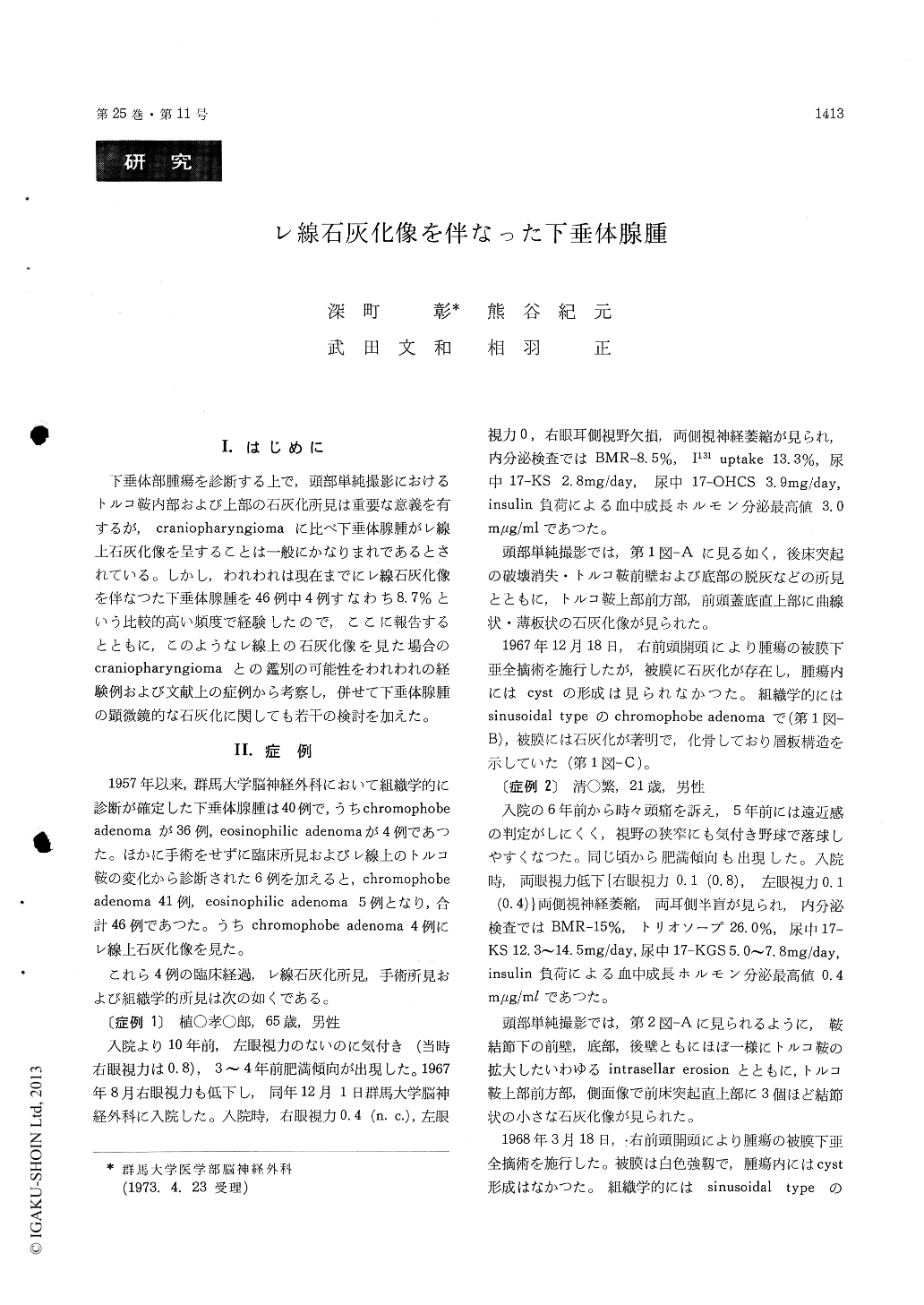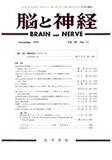Japanese
English
- 有料閲覧
- Abstract 文献概要
- 1ページ目 Look Inside
I.はじめに
下垂体部腫瘍を診断する上で,頭部単純撮影におけるトルコ鞍内部および上部の石灰化所見は重要な意義を有するが,craniopharyngiomaに比べ下垂体腺腫がレ線上石灰化像を呈することは一般にかなりまれであるとされている。しかし,われわれは現在までにレ線石灰化像を伴なつた下垂体膝腫を46例中4例すなわち8.7%という比較的高い頻度で経験したので,ここに報告するとともに,このようなレ線上の石灰化像を見た場合のcraniopharyngiomaとの鑑別の可能性をわれわれの経験例および文献上の症例から考察し,併せて下垂体腺腫の顕微鏡的な石灰化に関しても若干の検討を加えた。
Although it is said generally that roentgenolo-gical calcification in pituitary adenoma is extremely rare, we have experienced since 1957 four cases with calcification in 46 cases of pituitary adenomas (41 cases of chromophobe adenomas and 5 cases of eosinophilic ones). They were reported in the paper and microscopical calcifications in 20 cases of chromophobe adenomas were studied.
The first case was a 65-yearold male with loss of left visual acuity for ten years. At the admis-sion to our hospital, he was found to have a bilateral optic atrophy and a right temporal hemi- anopia. Plain craniogram revealed a complete destruction of the dorsum sellae, decalcification of the anterior wall and base of the sella and a thin and curvi-linear calcification in the suprasellar region just above the anterior base of the skull. Histologically this tumor was a chromophobe ade-noma of sinusoidal type.
The second case was a 21-yearold male with narrowness of the visual fields for 6 years. At the admission, there were a bilateral optic atrophy with disturbance of visual acuity and a bitemporal hemianopia. Plain craniogram disclosed a so-called intrasellar erosion and three pieces of small and nodular calcifications in the suprasellar region just above the anterior clinoid process. Histologically it was a chromophobe adenoma of sinusoidal type.
The third case was a 26-yearold female having left visual disturbance for about 4 years. At the admission, she was found to have an obesity, an amenorrhea, a right hemiparesis, a bilateral optic atrophy with disturbance of visual acuity and low values of endocrinological examinations (BMR, GH, etc.). Radiographs of the skull showed a thin and semicircular calcification and a piece of nodular one in the suprasellar region together with a de-struction of the dorsum sellae and a decalcification of the anterior wall of the sells. Histologically it was a chromophobe adenoma of diffuse type with slight amont of mitosis.
The last case was a 57-yearold male with a left visual disturbance for 12 years. At the admission, there were an impotence with absence of axillary and pubic hairs, a bilateral optic atrophy with disturbance of visual acuity and low values of urinary 17-KS and 17-KGS and GH. Radiographs of the skull revealed a complete destruction of the sella and a very thick and irregular calcifica-tion in the posterior part of the suprasellar re-gion. In operation a unilocular cyst with calcifi-cation of the wall was found. Histologically it was a chromophobe adenoma of diffuse type.
From these cases and the literatures, it was proposed that the diagnosis of the pituitary ade-noma would be roentgenologically possible if calci-fication, especially curvi-linear one, extends to the suprasellar region from just above the sella and marked sellar alteration is found without any other roentgenological signs of increased intracranial pressure.
Finally by the meticulous examination of 20 cases of chromophobe adenomas, microscopical calcifications were found in 25% of 20 cases of tumor tissues and in 45.4% of 11 cases of capsules.

Copyright © 1973, Igaku-Shoin Ltd. All rights reserved.


